Structure and Mechanical Properties of PVD and CVD TiAlSiN Coatings Deposited on Cemented Carbide
Abstract
1. Introduction
2. Materials and Methods
2.1. Deposition
2.2. Characterization
3. Results and Discussion
3.1. Chemical Composition and Structure of the As-Deposited CVD TiAlSiN and PVD TiAlSiN Coatings
3.2. Microstructure and Morphology Studies of the As-Deposited CVD TiAlSiN and PVD TiAlSiN Coatings
3.3. Mechanical Properties of the As-Deposited CVD TiAlSiN and PVD TiAlSiN Coatings
4. Conclusions
Author Contributions
Funding
Data Availability Statement
Acknowledgments
Conflicts of Interest
References
- Shao, L.J. Study on oxidation resistant behavior at high-temperature on TiN, TiAlN coaatings prepared by unbalanced magnetron sputtering. Hot Work. Technol. 2009, 38, 93–95. (In Chinese) [Google Scholar] [CrossRef]
- Anderbouhr, S.; Ghetta, V.; Blanquet, E.; Chabrol, C.; Schuster, F.; Bernard, C.; Madar, R. LPCVD and PACVD (Ti,Al)N films: Morphology and mechanical properties. Surf. Coat. Technol. 1999, 115, 103–110. [Google Scholar] [CrossRef]
- Todt, J.; Pitonak, R.; Köpf, A.; Weißenbacher, R.; Sartory, B.; Burghammer, M.; Daniel, R.; Schöberl, T.; Keckes, J. Superior oxidation resistance, mechanical properties and residual stresses of an Al-rich nanolamellar Ti0.05Al0.95N coating prepared by CVD. Surf. Coat. Technol. 2014, 258, 1119–1127. [Google Scholar] [CrossRef]
- Keckes, J.; Daniel, R.; Mittere, C.r.; Matko, I.; Sartory, B.; Koepf, A.; Weißenbacher, R.; Pitonak, R. Self-organized periodic soft-hard nanolamellae in polycrystalline TiAlN thin films. Thin Solid Films 2013, 545, 29–32. [Google Scholar] [CrossRef]
- Todt, J.; Zalesak, J.; Daniel, R.; Pitonak, R.; Köpf, A.; Weißenbacher, R.; Sartory, B.; Mitterer, C.; Keckes, J. Al-rich cubic Al0.8Ti0.2N coating with self-organized nano-lamellar microstructure: Thermal and mechanical properties. Surf. Coat. Technol. 2016, 291, 89–93. [Google Scholar] [CrossRef]
- Endler, I.; Höhn, M.; Herrmann, M.; Pitonak, R.; Ruppi, S.; Schneider, M.; van den Berg, H.; Westphal, H. Novel aluminum-rich Ti1-xAlxN coatings by LPCVD. Surf. Coat. Technol. 2008, 203, 530–533. [Google Scholar] [CrossRef]
- Ahmed, M.S.; Munroe, P.; Jiang, Z.T.; Zhao, X.; Rickard, W.; Zhou, Z.F.; Li, L.K.Y.; Xie, Z. Corrosion behaviour of nanocomposite TiSiN coatings on steel substrates. Corros. Sci. 2011, 53, 3678–3687. [Google Scholar] [CrossRef]
- Dang, C.; Li, J.; Wang, Y.; Chen, J. Structure, mechanical and tribological properties of self-toughening TiSiN/Ag multilayer coatings on Ti6Al4V prepared by arc ion plating. Appl. Surf. Sci. 2016, 386, 224–233. [Google Scholar] [CrossRef]
- Wan, Q.; Ding, H.; Yousaf, M.; Chen, Y.; Liu, H.; Hu, L.; Yang, B. Corrosion behaviors of TiN and Ti-Si-N (with 2.9 at.% and 5.0 at.% Si) coatings by electrochemical impedance spectroscopy. Thin Solid Films 2016, 616, 601–607. [Google Scholar] [CrossRef]
- Zhang, M.; Ma, S.; Xu, K.; Bai, L.; Chu, P.K. Bio-tribological properties and cyto-compatibility of Ti-Si-N coatings. Vacuum 2015, 115, 50–57. [Google Scholar] [CrossRef]
- Qiu, L.C.; Du, Y.; Wang, S.Q.; Li, K.; Yin, L.; Wu, L.Y.; Zhong, Z.Q.; Albir, L. Mechanical properties and oxidation resistance of chemically vapor deposited TiSiN nanocomposite coating with thermodynamically designed compositions. Int. J. Refract. Met. Hard Mater. 2019, 80, 30–39. [Google Scholar] [CrossRef]
- Carvalho, S.; Rebouta, L.; Ribeiro, E.; Vaz, F.; Denannot, M.F.; Pacaud, J.; Riviere, J.P.; Paumier, F.; Gaboriaud, R.J.; Alves, E. Microstructure of (Ti,Si,Al)N nanocomposite coatings. Surf. Coat. Technol. 2004, 177–178, 369–375. [Google Scholar] [CrossRef]
- Barshilia, H.C.; Ghosh, M.; Shashidhara; Ramakrishna, R.; Rajam, K.S. Deposition and characterization of TiAlSiN nanocomposite coatings prepared by reactive pulsed direct current unbalanced magnetron sputtering. Appl. Surf. Sci. 2010, 256, 6420–6426. [Google Scholar] [CrossRef]
- Liang, F.; Wang, H.J.; Zou, C.W. Effects of ion source voltages on the composition, hardness, and temperature-dependent tribological properties of Ti-Al-Si-N nanocomposite coatings. Jpn. J. Appl. Phys. 2014, 53, 075503. [Google Scholar] [CrossRef]
- Carvalho, S.; Rebouta, L.; Cavaleiro, A.; Rocha, L.A.; Gomes, J.; Alves, E. Microstructure and mechanical properties of nanocomposite (Ti,Si,Al)N coatings. Thin Solid Films 2001, 398–399, 391–396. [Google Scholar] [CrossRef]
- Gao, F.Y.; Li, G.; Xia, Y. Influence of hysteresis effect on properties of reactively sputtered TiAlSiN films. Appl. Surf. Sci. 2018, 431, 160–164. [Google Scholar] [CrossRef]
- Carvalho, S.; Rebouta, L.; Ribeiro, E.; Vaz, F.; Tavares, C.J.; Alves, E.; Barradas, N.P.; Riviere, J.P. Structural evolution of Ti–Al–Si–N nanocomposite coatings. Vacuum 2009, 83, 1206–1212. [Google Scholar] [CrossRef]
- Kim, S.K.; Vinh, P.V.; Kim, J.H.; Ngoc, T. Deposition of superhard TiAlSiN thin films by cathodic arc plasma deposition. Surf. Coat. Technol. 2005, 200, 1391–1394. [Google Scholar] [CrossRef]
- Liu, J.; Zhu, S.S.; Deng, X.; Liu, J.Y.; Wang, Z.P.; Qu, Z. Cutting Performance and Wear Behavior of AlTiN- and TiAlSiN-Coated Carbide Tools During Dry Milling of Ti–6Al–4V. Acta Metall. Sin. Eng. Lett. 2020, 33, 135–146. [Google Scholar] [CrossRef]
- Lee, J.H.; Oh, I.H.; Jang, J.H.; Kim, J.H.; Hong, S.K.; Park, H.K. Influence of Phase Composition in TiAlSiN Hard Coatings on the Evolution of Structure and Mechanical Properties. Met. Mater. Int. 2020, 1–11. [Google Scholar] [CrossRef]
- Wang, M.C.; Wang, L.J.; Chen, H.; Cheng, Y.F. Study on the phase structure and mechanical properties of (Ti,Al,Si)N coatings deposited by multiarc ion plating. Int. J. Mod. Phys. B 2020, 34, 2040043. [Google Scholar] [CrossRef]
- Song, Z.H.; Dai, M.J.; Li, H.; Hong, Y.; Lin, S.S.; Shi, Q.; Su, Y.F. Effect of Arc Ion Plating Bias on Structure and Properties of TiAlSiN Films. Surface Technol. 2020, 49, 306–314. (In Chinese) [Google Scholar] [CrossRef]
- Rafaja, D.; Poklad, A.; Klemm, V.; Schreiber, G.; Heger, D.; Šíma, M.; Dopita, M. Some consequences of the partial crystallographic coherence between nanocrystalline domains in Ti–Al–N and Ti–Al–Si–N coatings. Thin Solid Films 2016, 514, 240–249. [Google Scholar] [CrossRef]
- Chen, L.; Du, Y.; Wang, A.J.; Wang, S.Q.; Zhou, S.Z. Effect of Al content on microstructure and mechanical properties of Ti–Al–Si–N nanocomposite coatings. Int. J. Refract. Met. Hard Mater. 2009, 27, 718–721. [Google Scholar] [CrossRef]
- Chang, C.L.; Lee, J.W.e.i.; Tseng, M.D. Microstructure, corrosion and tribological behaviors of TiAlSiN coatings deposited by cathodic arc plasma deposition. Thin Solid Films 2009, 517, 5231–5236. [Google Scholar] [CrossRef]
- Chen, L.; Wang, S.Q.; Du, Y.; Zhou, S.Z.; Gang, T.; Fen, J.C.; Chang, K.K.; Li, Y.W.; Xiong, X. Machining performance of Ti–Al–Si–N coated inserts. Surf. Coat. Technol. 2010, 205, 582–586. [Google Scholar] [CrossRef]
- Flink, A.; Andersson, J.; Alling, B.; Daniel, R.; Sjölén, J.; Karlsson, L.; Hultman, L. Structure and thermal stability of arc evaporated (Ti0.33Al0.67)1-xSixN thin films. Thin Solid Films 2008, 517, 714–721. [Google Scholar] [CrossRef]
- Chang, Y.Y.; Lai, H.M. Wear behavior and cutting performance of CrAlSiN and TiAlSiN hard coatings on cemented carbide cutting tools for Ti alloys. Surf. Coat. Technol. 2014, 259, 152–158. [Google Scholar] [CrossRef]
- Park, I.W.; Choi, S.R.; Suh, J.H.; Park, C.G.; Kim, K.H. Deposition and mechanical evaluation of superhard Ti-Al-Si-N nanocomposite films by a hybrid coating system. Thin Solid Films 2004, 447–448, 443–448. [Google Scholar] [CrossRef]
- Du, H.; Zhao, H.B.; Xiong, J.; Xian, G. Effect of interlayers on the structure and properties of TiAlN based coatings on WC-Co cemented carbide substrate. Int. J. Refract. Met. Hard Mater. 2013, 37, 60–66. [Google Scholar] [CrossRef]
- Yu, D.H.; Wang, C.Y.; Cheng, X.L.; Zhang, F.L. Microstructure and properties of TiAlSiN coatings prepared by hybrid PVD technology. Thin Solid Films 2009, 517, 4950–4955. [Google Scholar] [CrossRef]
- Li, Y.S.; Shimada, S.; Kiyono, H.; Hirose, A. Synthesis of Ti-Al-Si-N nanocomposite films using liquid injection PECVD from alkoxide precursors. Acta Mater. 2006, 54, 2041–2048. [Google Scholar] [CrossRef]
- Das, S.; Guha, S.; Ghadai, R.; Swain, B.P. A comparative analysis over different properties of TiN, TiAlN and TiAlSiN thin film coatings grown in nitrogen gas atmosphere. Mater. Chem. Phys. 2021, 258, 123866. [Google Scholar] [CrossRef]
- Zou, C.W.; Zhang, J.; Xie, W.; Shao, L.X.; Guo, L.P.; Fu, D.J. Characterization and properties Ti-Al-Si-N nanocomposite coatings prepared by middle frequency magnetron sputtering. Appl. Surf. Sci. 2011, 257, 10373–10378. [Google Scholar] [CrossRef]
- Zhao, F.; Wang, L.P.; Wang, X.F. Microstructure and properties of TiAlSiN ultra-hard coatings prepared by plasma immersion ion implantation and deposition with TiAlSi alloy cathodes. Vacuum 2020, 174, 109194. [Google Scholar] [CrossRef]
- Niederhofer, A.; Nesládek, P.; Männling, H.-D.; Moto, K.; Veprek, S.; Jĭlek, M. Structural properties, internal stress and thermal stability of nc-TiN/a-Si3N4, nc-TiN/TiSix and nc-(Ti1−yAlySix)N superhard nanocomposite coatings reaching the hardness of diamond. Surf. Coat. Technol. 1999, 120–121, 173–178. [Google Scholar] [CrossRef]
- Chen, L.; Yang, B.; Xu, Y.X.; Pei, F.; Zhou, L.C.; Du, Y. Improved thermal stability and oxidation resistance of Al-Ti-N coating by Si addition. Thin Solid Films 2014, 556, 369–375. [Google Scholar] [CrossRef]
- Coll, B.F.; Fontana, R.; Gates, A.; Sathrum, P. (Ti,Al)N advanced films prepared by arc process. Mater. Sci. Eng. A 1991, 140, 816–824. [Google Scholar] [CrossRef]
- Suzuki, T.; Huang, D.; Ikuhara, Y. Microstructures and grain boundaries of (Ti,Al)N films. Surf. Coat. Technol. 1998, 107, 41–47. [Google Scholar] [CrossRef]
- Jindal, P.C.; Santhanam, A.T.; Schleinkofer, U.; Shuster, A.F. Performance of PVD TiN, TiCN, and TiAlN coated cemented carbide tools in turning. Int. J. Refract. Met. Hard Mater. 1999, 17, 163–170. [Google Scholar] [CrossRef]
- Kimura, A.; Hasegawa, H.; Yamada, K.; Suzuki, T. Metastable Ti1-xAlxN films with different Al content. J. Mater. Sci. Lett. 2000, 19, 601–602. [Google Scholar] [CrossRef]
- Zou, L.L. Study on Properties of Nano-multilayer TiAlSiN Coating Prepared by Multi-arc Ion Plating. Mech. Eng. 2018, 8, 98–100. (In Chinese) [Google Scholar] [CrossRef]
- Parlinska-Wojtan, M.; Karimi, A.; Cselle, T.; Morstein, M. Conventional and high resolution TEM investigation of the microstructure of compositionally graded TiAlSiN thin films. Surf. Coat. Technol. 2004, 177–178, 376–381. [Google Scholar] [CrossRef]
- Zhang, Y.J.; Yang, Y.Z.; Ding, H.W.; Peng, Y.; Zhang, S.M.; Yu, L.G.; Zhang, P.Y. Combining magnetic filtered cathodic arc deposition with ion beam sputtering to afford superhard TiSiN multilayer composite fifilms with tunable microstructure and mechanical properties. Vacuum 2016, 125, 6–12. [Google Scholar] [CrossRef]
- Guo, Y.; Ma, S.L.; Xu, K.W. On the oxidation resistance of superhard Ti–Si–C–N coatings. J. Mater. Res. 2008, 23, 2420–2428. [Google Scholar] [CrossRef]
- Zhang, S.; Sun, D.; Fu, Y.; Du, H. Toughening of hard nanostructural thin films: A critical review. Surf. Coat. Technol. 2005, 198, 2–8. [Google Scholar] [CrossRef]
- Liu, H.; Yang, F.C.; Tsai, Y.J.; Wang, X.; Li, W.; Chang, C.L. Effect of modulation structure on the microstructural and mechanical properties of TiAlSiN/CrN thin films prepared by high power impulse magnetron sputtering. Surf. Coat. Technol. 2019, 358, 577–585. [Google Scholar] [CrossRef]
- Ou, Y.X.; Lin, J.; Tong, S.; Che, H.L.; Sproul, W.D.; Lei, M.K. Wear and corrosion resistance of CrN/TiN superlattice coatings deposited by a combined deep oscillation magnetron sputtering and pulsed dc magnetron sputtering. Appl. Surf. Sci. 2015, 351, 332–343. [Google Scholar] [CrossRef]
- Leyland, A.; Matthews, A. On the significance of the H/E ratio in wear control: A nanocomposite coating approach to optimised tribological behavior. Wear 2000, 246, 1–11. [Google Scholar] [CrossRef]
- Leyland, A.; Matthews, A. Optimization of Nanostructured Tribological Coatings. In Nanostructured Coatings: Nanostructure Science and Technology; Cavaleiro, A., De Hosson, J.T.M., Eds.; Springer Science + Business Media LLC: New York, NY, USA, 2006; pp. 511–538. [Google Scholar] [CrossRef]
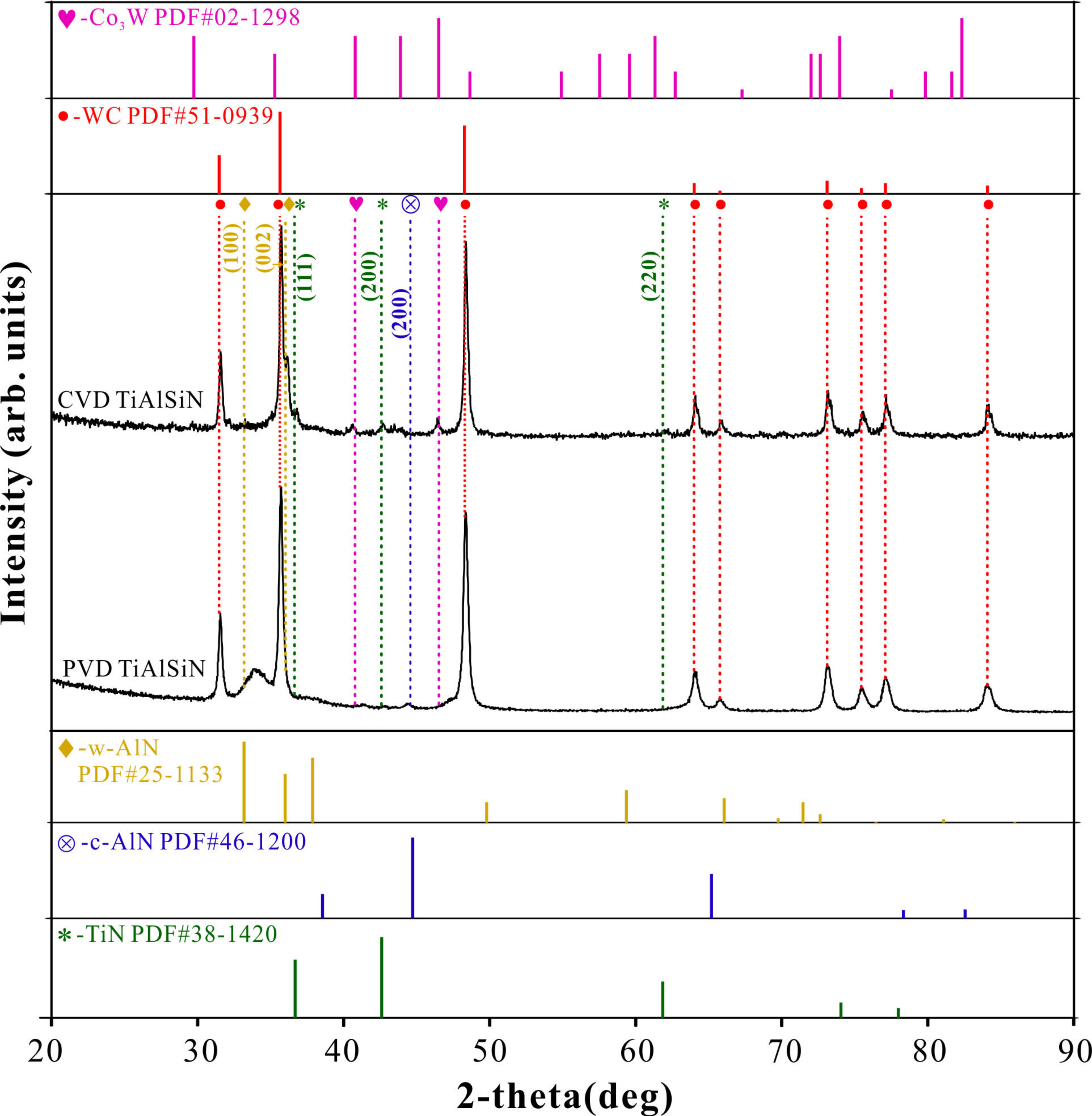
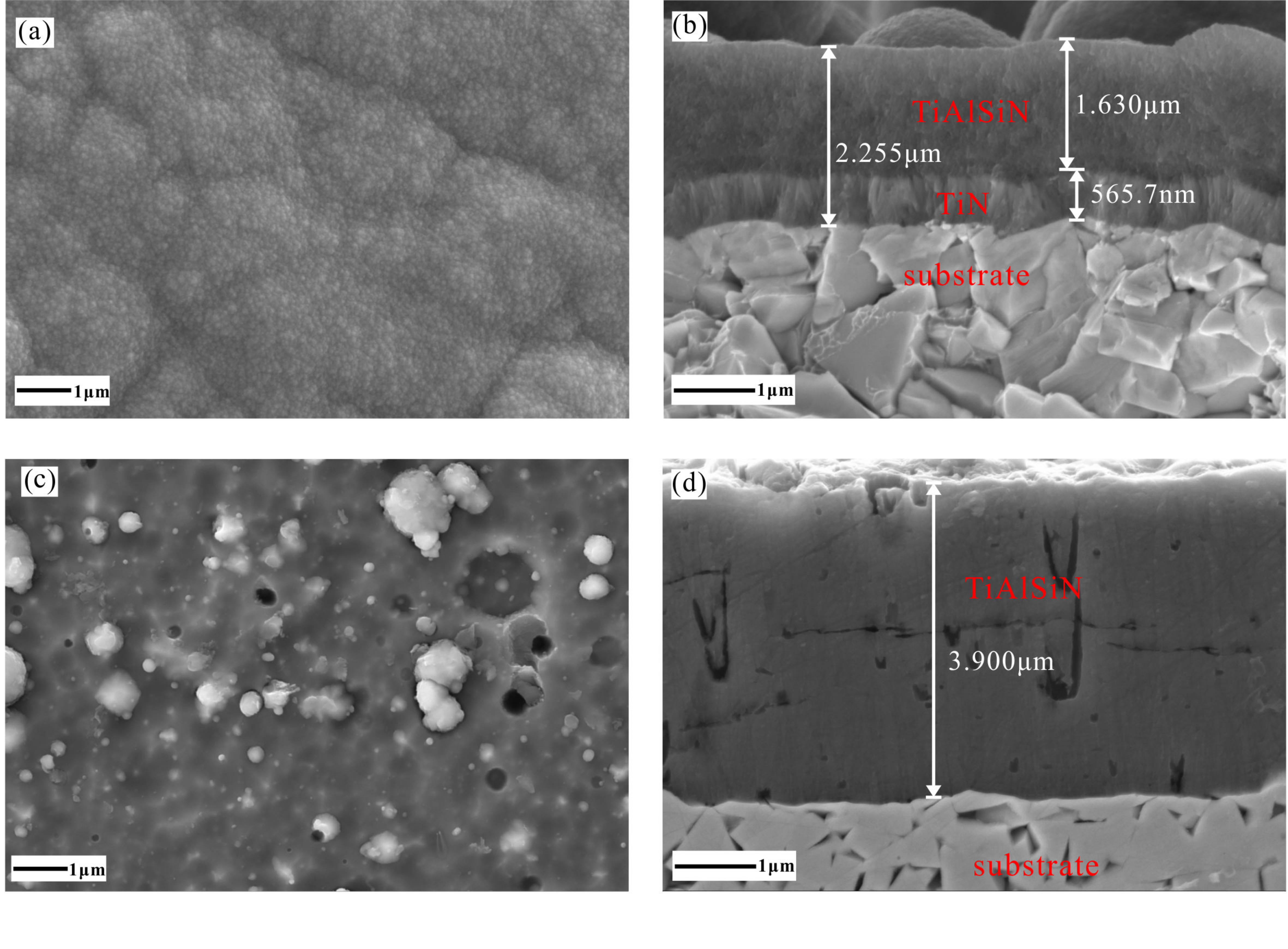
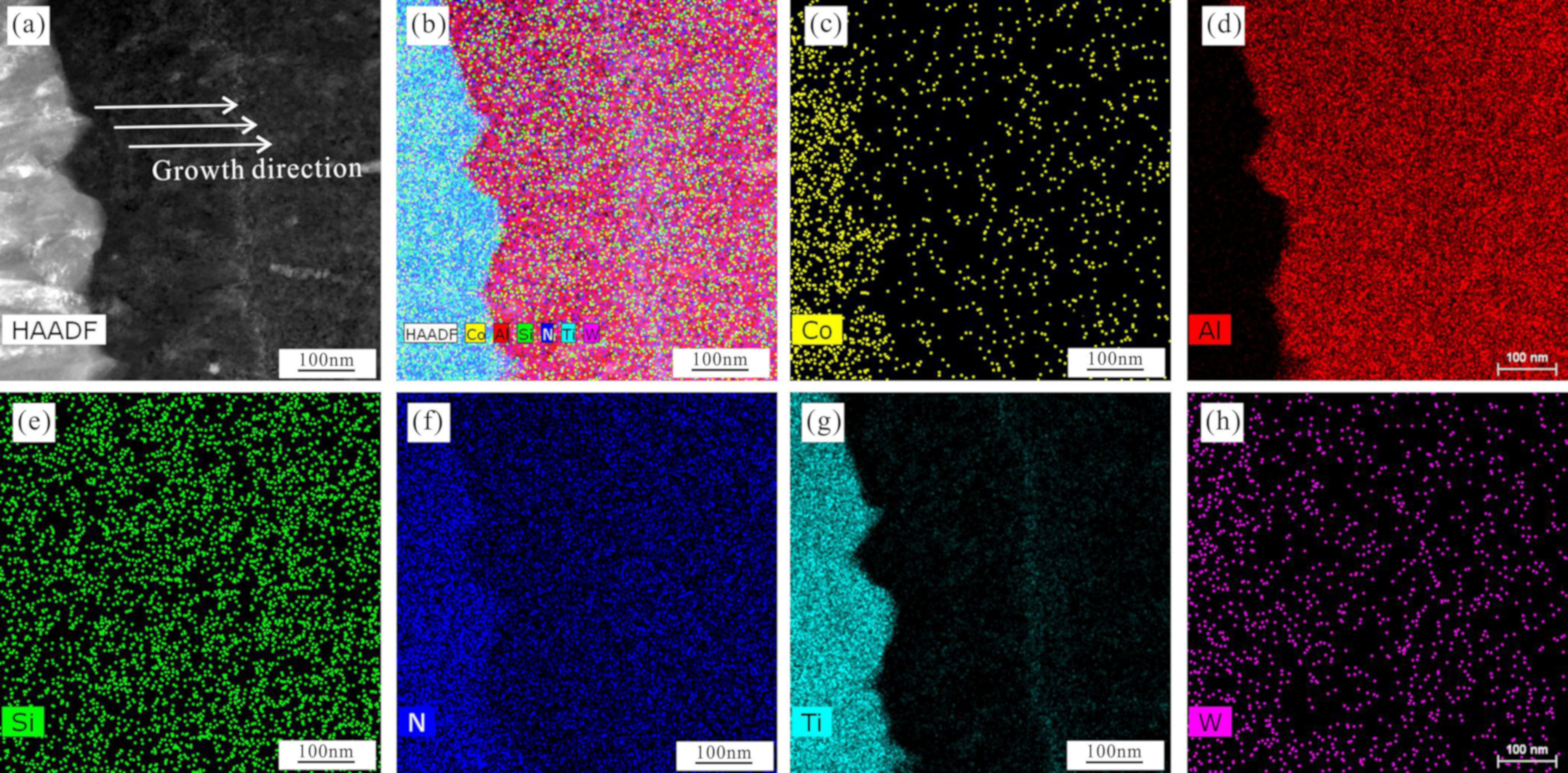
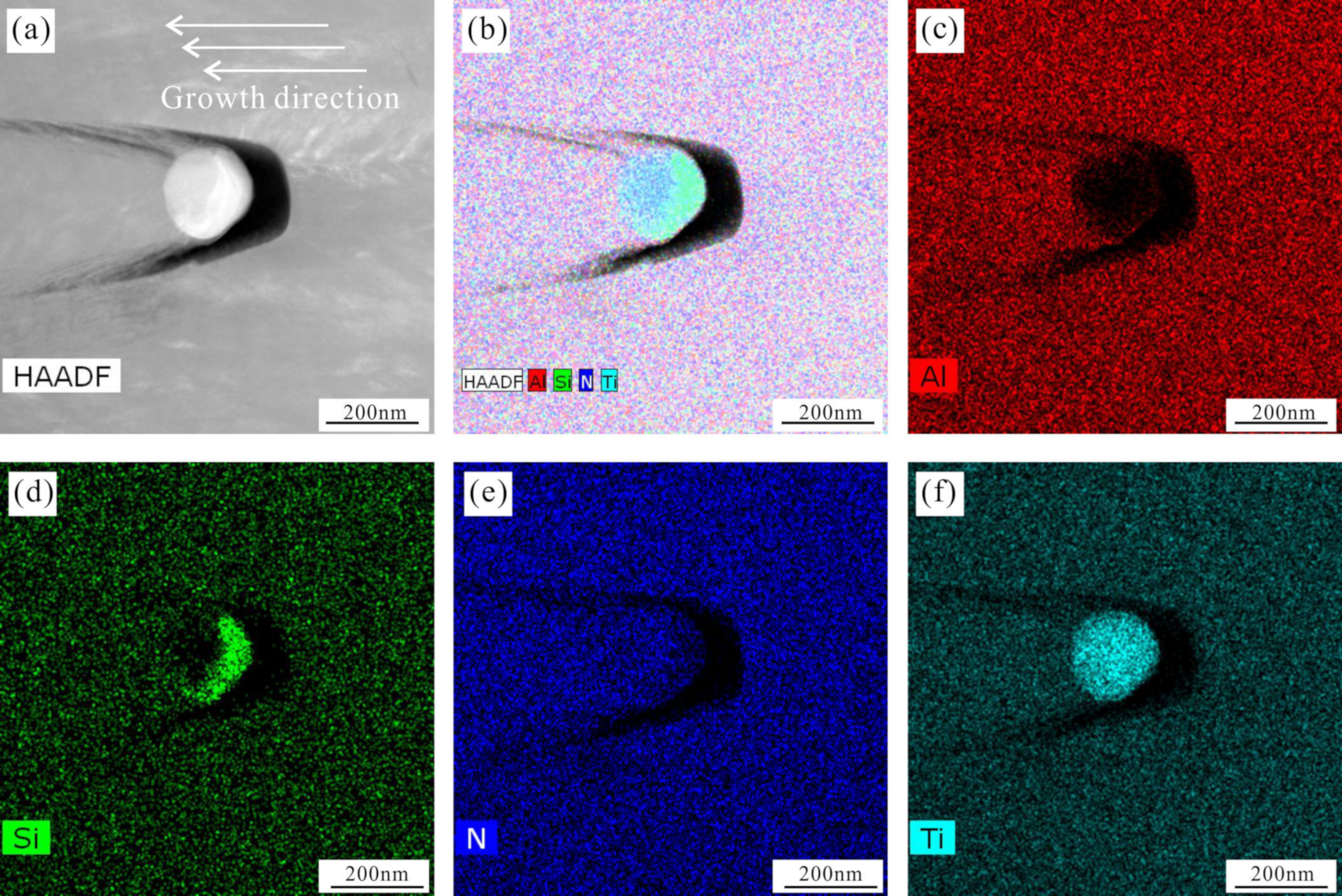
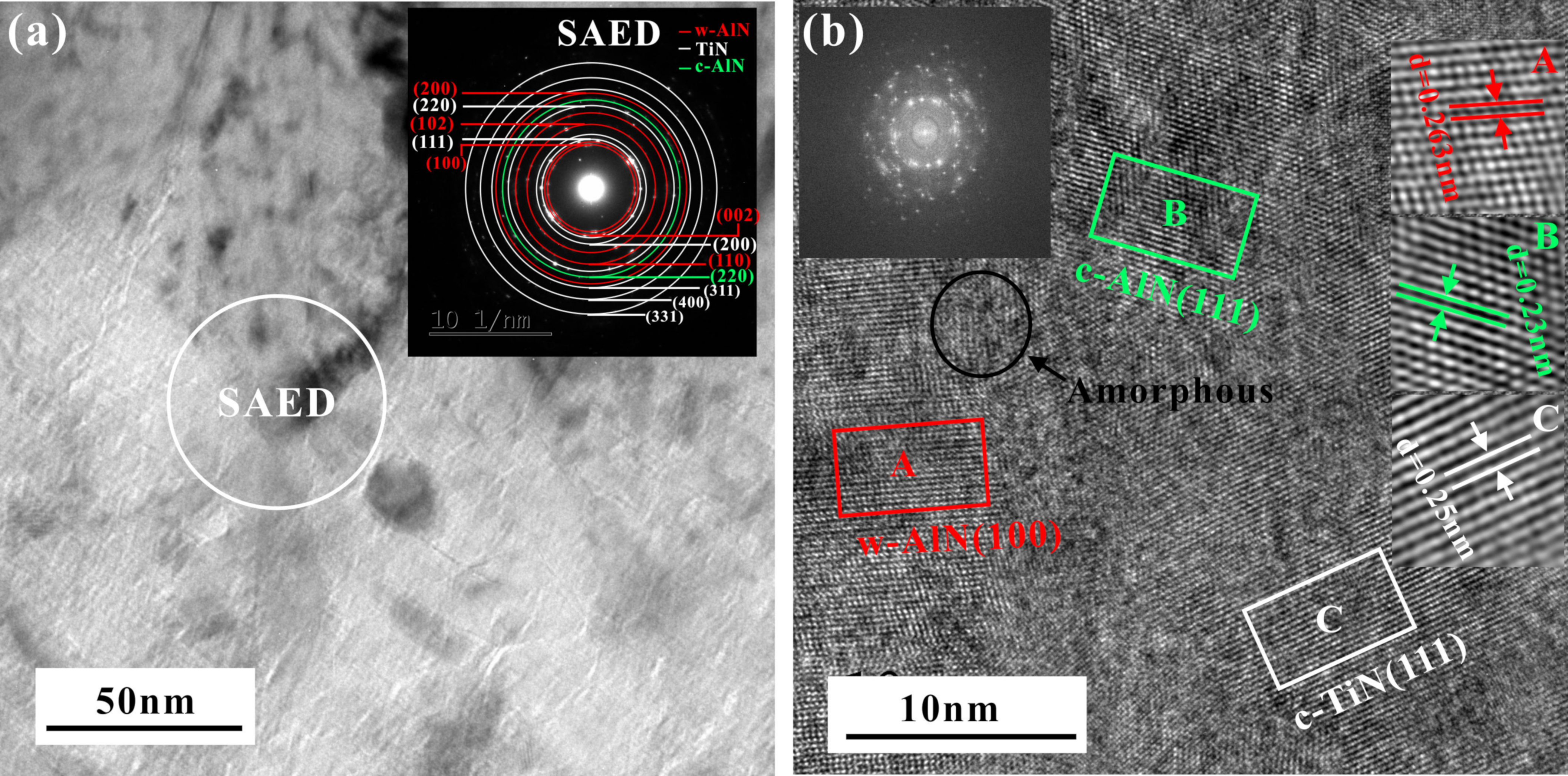
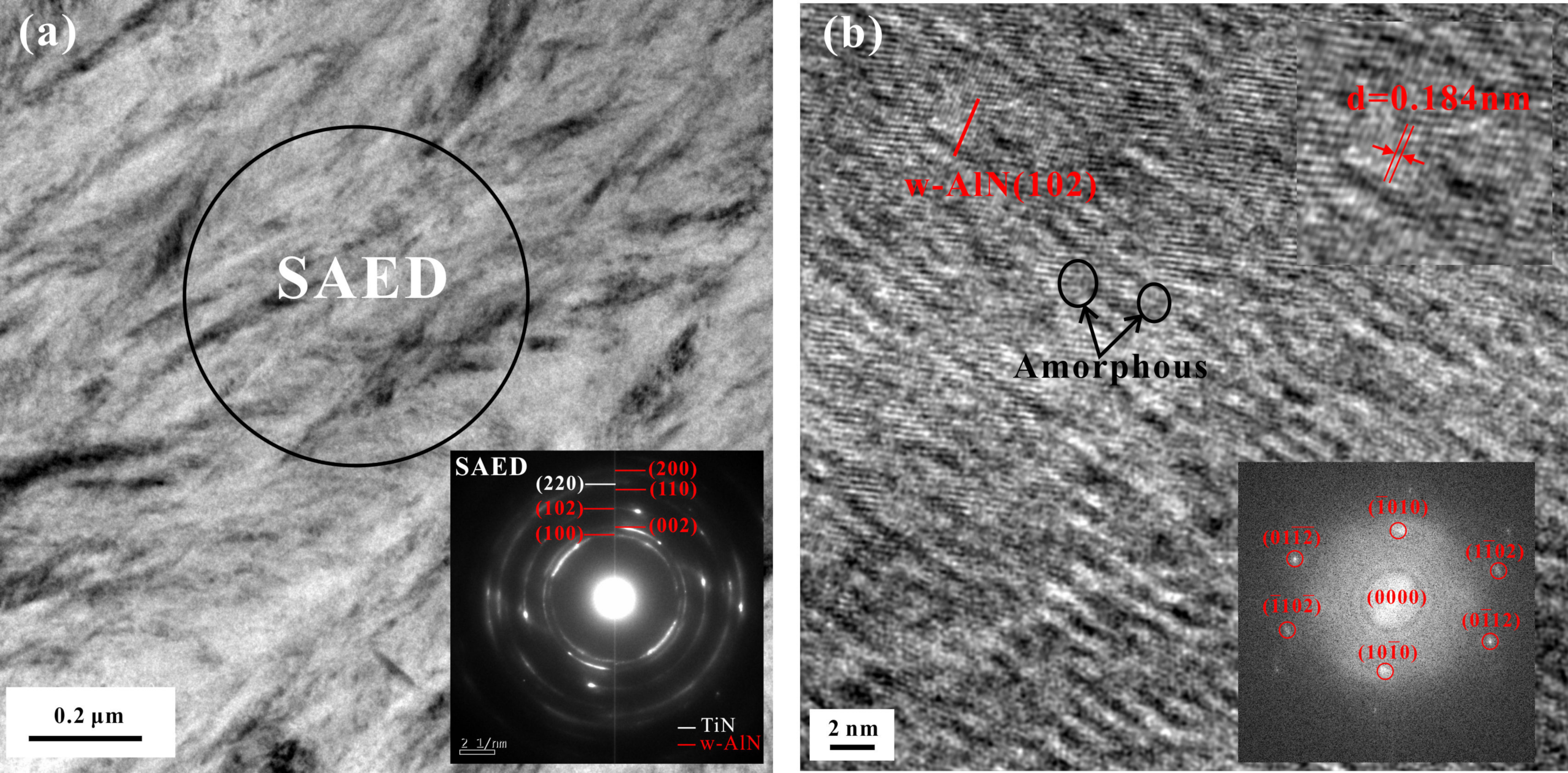
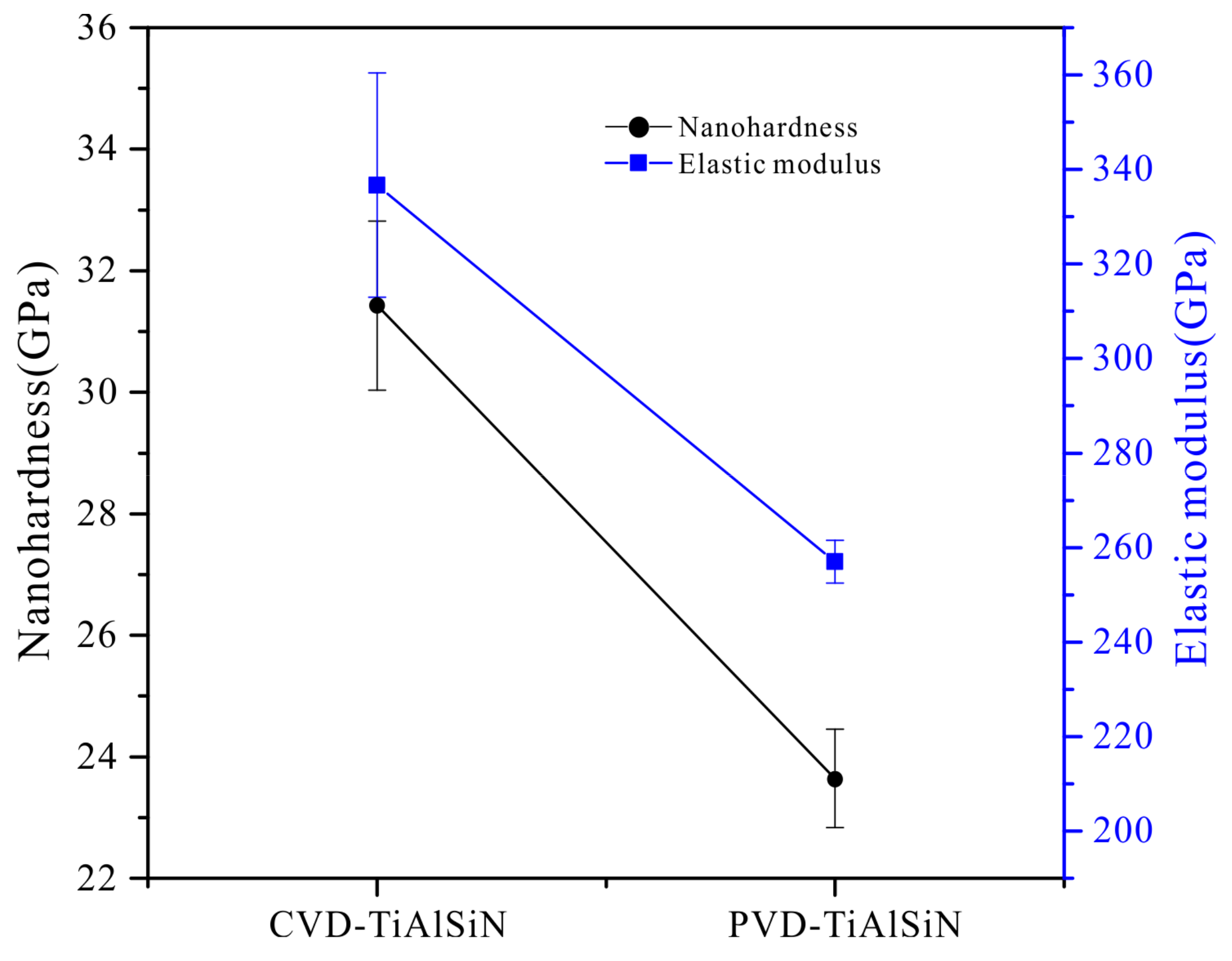
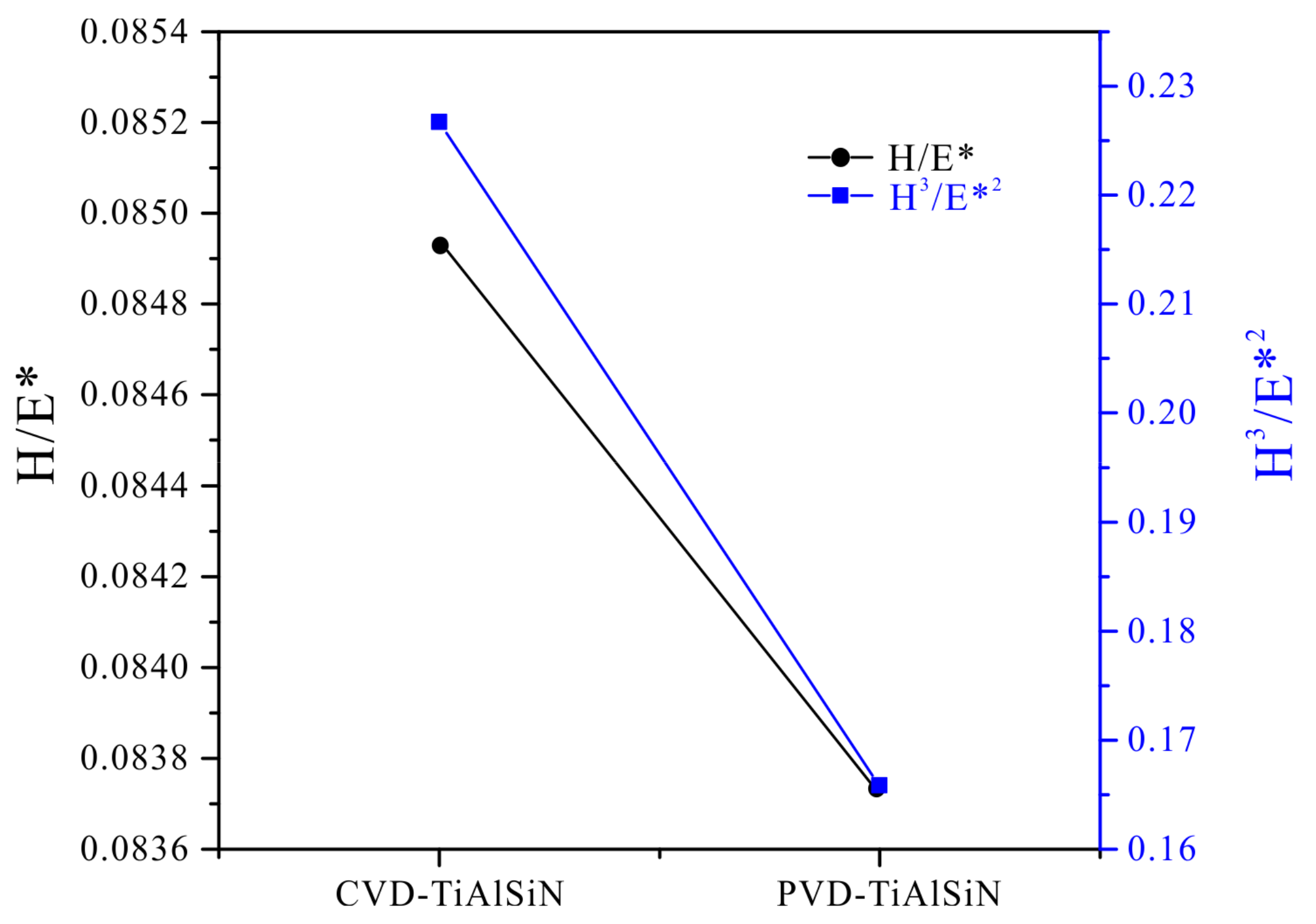
| Layer | Ti (at.%) | Al (at.%) | Si (at.%) | N (at.%) | Cl (at.%) | C (at.%) | W (at.%) | Co (at.%) | Sum (at.%) |
|---|---|---|---|---|---|---|---|---|---|
| CVD-TiAlSiN | 7.45 | 40.04 | 0.99 | 50.07 | 1.24 | / | 0.21 | / | 100 |
| CVD-TiN | 30.25 | 10.31 | / | 37.92 | 0.57 | 16.92 | 3.65 | 0.39 | 100 |
| PVD-TiAlSiN | 15.52 | 30.10 | 4.42 | 49.96 | / | / | / | / | 100 |
Publisher’s Note: MDPI stays neutral with regard to jurisdictional claims in published maps and institutional affiliations. |
© 2021 by the authors. Licensee MDPI, Basel, Switzerland. This article is an open access article distributed under the terms and conditions of the Creative Commons Attribution (CC BY) license (https://creativecommons.org/licenses/by/4.0/).
Share and Cite
Wu, L.; Qiu, L.; Du, Y.; Zeng, F.; Lu, Q.; Tan, Z.; Yin, L.; Chen, L.; Zhu, J. Structure and Mechanical Properties of PVD and CVD TiAlSiN Coatings Deposited on Cemented Carbide. Crystals 2021, 11, 598. https://doi.org/10.3390/cryst11060598
Wu L, Qiu L, Du Y, Zeng F, Lu Q, Tan Z, Yin L, Chen L, Zhu J. Structure and Mechanical Properties of PVD and CVD TiAlSiN Coatings Deposited on Cemented Carbide. Crystals. 2021; 11(6):598. https://doi.org/10.3390/cryst11060598
Chicago/Turabian StyleWu, Liying, Lianchang Qiu, Yong Du, Fangfang Zeng, Qiang Lu, Zhuopeng Tan, Lei Yin, Liyong Chen, and Jifei Zhu. 2021. "Structure and Mechanical Properties of PVD and CVD TiAlSiN Coatings Deposited on Cemented Carbide" Crystals 11, no. 6: 598. https://doi.org/10.3390/cryst11060598
APA StyleWu, L., Qiu, L., Du, Y., Zeng, F., Lu, Q., Tan, Z., Yin, L., Chen, L., & Zhu, J. (2021). Structure and Mechanical Properties of PVD and CVD TiAlSiN Coatings Deposited on Cemented Carbide. Crystals, 11(6), 598. https://doi.org/10.3390/cryst11060598






